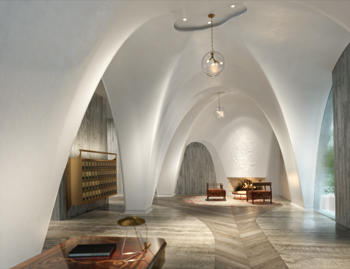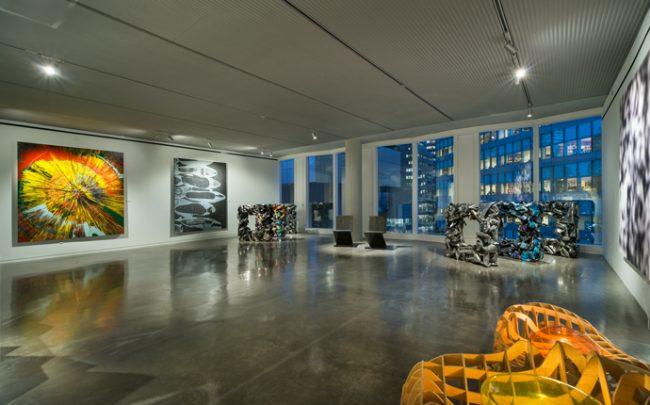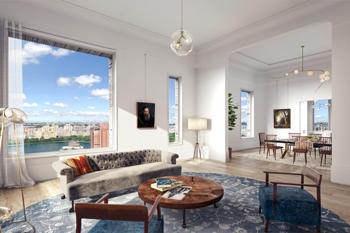Billboards for Greenwich West, a 167-unit luxury condo in Soho, will begin cropping up downtown before its sales launch next month. But instead of using traditional computer-generated renderings, the signs will feature custom work by a Brooklyn-based painter.
One piece offers glimpses of life inside the building. Looking through the windows, there’s a young boy playing with toy airplanes; in another, a woman napping on the sofa. Against the backdrop of the orange sky, a woman on the terrace looks out at a sailboat. A breeze runs through her hair.
“They basically tell a little story about about what’s happening in that space,” said Phillip Gesue, chief development officer at developer Strategic Capital. “The viewer can envision a narrative of what life is like there.”
The marketing campaign is just one example of how art is playing an evolving role in residential new development, as brokers and developers seek to differentiate their units to attract buyers in an oversupplied market.
“Much or most of the campaign will have its basis in the artwork of this artist,” Gesue said. “Everybody is looking for a means of identifying their projects.”
Art’s role in real estate isn’t new — but it’s increasingly become part of how that identity is shaped. In a slower market, as buyers have plenty of choices and take the time to shop around, brokers and developers said it’s crucial to find ways to stand out. While art alone won’t close deals, it’s part of the effort: projects have work by commissioned artists or amenities to appeal to buyers who are collectors.
In Joe McMillan’s view, art has become more incorporated — literally — into new development. The lobby of his firm’s luxury condo at 180 East 88th Street features a custom hand-sculpted plaster wall by German artist Jan Hooss.

A rendering of 180 East 88th Street’s lobby (Credit: March Made for DDG)
“It’s part of the fabric of the building,” the DDG chairman and CEO said. That’s a shift from when the developer worked with an art gallery to stage model units in 2011, he said. “You want to have a permanence.”
The 88th Street project is also going after buyers tied closely to the art world. Its units have 14-foot-plus ceilings and an art rail — similar to the one used at the Metropolitan Museum of Art — around the perimeter allows owners to turn a living room into a gallery space. The idea is designed to lure buyers with “well-thought out art collections,” McMillan said.
Whatever the approach, there’s no denying the need to make an impression. In the second quarter, the number of sales closed for new development properties in Manhattan tumbled 37 percent from a year earlier, according to Douglas Elliman. At the same time, the median sales price slid 19 percent.
Amid the slowdown, listings, especially on the high end, have been languishing on the market. In the last week of July, luxury properties that went into contract were sitting on the market for an average of 536 days, according to Olshan Realty. When units do sell, it’s often at steep discounts.
“People ask me what matters most in showing. Everything matters, every little detail,” said Compass’ Leonard Steinberg. “It’s a lot of pressure. Now things are more competitive.”
Steinberg is marketing Aby Rosen’s 100 East 53rd Street — an ultra-luxury development that has reportedly drawn buyers like George and Amal Clooney and Cindy Crawford. The building, which struggled with construction delays and slow sales last year, features art from Rosen’s own collection. Its sales gallery is sprinkled with works from iconic artists like Andy Warhol and Jeff Koons.

100 East 53rd Street (Credit: Bjorg Magnea)
The developer doesn’t share sales numbers, Steinberg said, though StreetEasy shows nine units in the building are currently in contract. Units on the market range from the $65 million penthouse to a $3.9 million apartment on the sixth floor.
“Quality and appreciation for better art is becoming much more of a focus among the wealthy,” Steinberg said. In other words: buyers have come to expect more.
The Naftali Group tried a different technique when staging the remaining seven apartments at the Shephard, a 38-unit condo in the West Village. The developer worked with Interior Marketing Group to set up each of the units differently and spent “a considerable amount of time” finding art for the building, said Danielle Naftali, who manages marketing, art and design for the company. It bought more than 50 pieces.
There was a clear scenario the team was trying to avoid: “Many times buyers walk through four or five units, and it’s hard to keep track of ones that look the same,” she said.
In staging the apartments, the team sought out art to match the buyer demographic each unit would appeal to. Large works, including sculptures, were brought in to give buyers a sense of scale and show them how their own collections could fit into the space, said IMG’s Cheryl Eisen. A penthouse, for example, had softer colors and the “spacious and calm” design sought to give it a family-friendly feel, she said.

A living room of 180 88th Street (Credit: March Made for DDG)
The building has seen increased traffic, Naftali said, with prospective buyers making repeat visits. Penthouse A, listed at $18.9 million, is in contract.
While developers declined to provide specifics on how the art aspect affects marketing budgets, it can prove more costly than more traditional techniques.
“Any campaign that utilizes art requires that an artist create original works that can be costly relative to a normal graphic art campaign,” Strategic Capital’s Gesue said.
Though approaches vary, the underlying goal is the same: prospective buyers need to be able to envision themselves in a property. There’s no telling whether a dramatic billboard or meticulous staging will do the trick, but the methods are catering to a buyer pool that’s come to demand more.
“It’s a natural evolution of sophistication of the market,” McMillan said. “Buyers have a right to have high expectations.”
